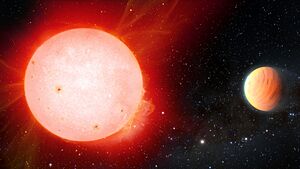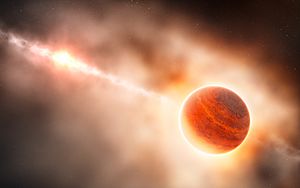Gas giant facts for kids
A gas giant is a huge giant planet mostly made of hydrogen and helium. In our Solar System, Jupiter and Saturn are the two main gas giants.
For a long time, all giant planets were called "gas giants." But in the 1990s, scientists learned that Uranus and Neptune are actually different. They are mostly made of heavier elements called "ices" (like water, methane, and ammonia). Because of this, Uranus and Neptune are now often called ice giants.
Jupiter and Saturn are mostly hydrogen and helium. Only a small part of their mass (3 to 13 percent) comes from heavier elements. Scientists think they have an outer layer of compressed hydrogen gas. Below that is a layer of liquid metallic hydrogen. Deep inside, they probably have a molten rocky core.
The very top part of their hydrogen atmosphere has many layers of clouds. These clouds are mostly made of water and ammonia. The metallic hydrogen layer in the middle of the planet is "metallic" because the huge pressure turns hydrogen into something that can conduct electricity. The cores of gas giants are thought to be made of heavier elements. They are super hot (around 20,000 K) and under extreme pressure. Scientists are still trying to understand them fully.
It's a bit tricky to tell the difference between a very low-mass brown dwarf (which can be about 13 times the mass of Jupiter) and a gas giant. Some scientists look at how they formed. Others look at what they are made of inside. Part of the discussion is whether brown dwarfs must have had nuclear fusion happening inside them at some point.
Contents
What is a Gas Giant?
The name gas giant was first used in 1952 by a science fiction writer named James Blish. At first, it meant all giant planets.
However, the name can be a bit confusing. This is because most of a giant planet is under such high pressure that matter isn't really in a "gaseous" form. Except for solids in the core and the very top of the atmosphere, everything else is above its critical point. At this point, there's no clear difference between a liquid and a gas.
Even so, the name "gas giant" stuck. This is because planetary scientists often use "rock," "gas," and "ice" as simple terms for the main ingredients of planets. They use these terms no matter what phase the matter is in. In the outer Solar System, hydrogen and helium are called "gases." Water, methane, and ammonia are called "ices." Silicates and metals are called "rocks." So, since Uranus and Neptune are mostly made of "ices," they are called ice giants. This makes them different from gas giants, which are mostly "gas."
Types of Gas Giants
Scientists can divide gas giants into five different groups. This is based on what their atmospheres are like. These groups are: ammonia clouds (Type I), water clouds (Type II), cloudless (Type III), alkali-metal clouds (Type IV), and silicate clouds (Type V).
Jupiter and Saturn are both Type I gas giants. Some planets outside our Solar System, called Hot Jupiters, are Type IV or V.
Gas Giants Beyond Our Solar System

Cold Gas Giants
A cold gas giant that is rich in hydrogen and more massive than Jupiter, but less than about 1.6 Jupiter masses (500 Earth masses), will only be a little bit bigger than Jupiter. If a gas giant is more massive than 500 Earth masses, its own gravity will make it shrink.
Sometimes, a process called Kelvin–Helmholtz heating can make a gas giant give off more energy than it gets from its star.
Gas Dwarfs
Even though we call them "gas giants," planets made of hydrogen don't always have to be as big as Jupiter or Saturn. However, smaller gas planets and those closer to their star will lose their atmosphere faster. This happens through something called hydrodynamic escape.
A "gas dwarf" could be a planet with a rocky core that has gathered a thick layer of hydrogen, helium, and other gases. This would make its total size between 1.7 and 3.9 times the radius of Earth.
The smallest known planet outside our Solar System that is likely a "gas planet" is Kepler-138d. It has the same mass as Earth but is 60% larger. This means it has a low density, which suggests it has a thick gas layer. A small gas planet can still be as big as a gas giant if it has the right temperature.
Weather on Gas Giants
Storms on Jupiter
Heat moving upwards from local storms is a big reason for the weather on gas giants. Much of the deep heat escaping from inside these planets flows up through huge thunderstorms. These storms then turn into smaller swirling areas. Eventually, these can form giant storms like the Great Red Spot on Jupiter.
On Earth and Jupiter, lightning and the water cycle are closely connected. They work together to create strong thunderstorms. During a thunderstorm on Earth, water vapor turning into liquid releases heat. This pushes rising air upwards. This "moist convection" can separate electrical charges in a cloud. When these charges come back together, it creates lightning. So, lightning tells us where this convection is happening. Even though Jupiter has no ocean or wet ground, moist convection seems to work in a similar way to Earth.
Jupiter's Great Red Spot
The Great Red Spot (GRS) is a huge high-pressure storm in Jupiter's southern half. It's a powerful anticyclone, spinning counter-clockwise at about 430 to 680 kilometers per hour around its center. The Spot is known for being very strong, even absorbing smaller storms on Jupiter.
Tholins are brown organic compounds found on the surface of some planets. They form when exposed to UV light. Scientists think that tholins on Jupiter's surface get pulled up into the atmosphere by storms. These tholins then get trapped in Jupiter's Great Red Spot, which makes it red.
Helium Rain on Saturn and Jupiter
Helium can turn into liquid and fall as rain on gas giants. On Saturn, this happens at certain pressures and temperatures. At these conditions, helium doesn't mix with the liquid metallic hydrogen inside the planet. In areas where helium won't mix, the denser helium forms droplets. These droplets act as a source of energy. They release heat as they fall deeper into the planet's center. This separation causes helium droplets to fall through the liquid metallic hydrogen. They keep falling until they reach a warmer area where they dissolve back into the hydrogen.
Since Jupiter and Saturn have different total masses, the conditions inside them might be different. This means this helium rain process could happen more on Saturn than on Jupiter. Helium rain might explain why Saturn gives off more heat than it gets from the Sun. It also might explain why there is less helium in the atmospheres of both Jupiter and Saturn.
Diamond Rain on Uranus
Uranus does not have much internal heat. It is the coldest planet in our Solar System, with its upper atmosphere being about -224 °C. Deep inside Uranus's mantle, it is so hot and under such high pressure that methane breaks down into pure carbon. Scientists think that this could lead to diamond rain.
Higher up in the atmosphere, where conditions are milder, scientists have found products from methane breakdown. These include things like acetylene. It's likely that a lot of interesting chemical reactions are happening in the areas between where diamonds might form and the upper atmosphere.
See also
 In Spanish: Gigante gaseoso para niños
In Spanish: Gigante gaseoso para niños
- List of gravitationally rounded objects of the Solar System
- List of planet types
- Hot Jupiter
- Ice giant
- Kepler-1704b
- Brown dwarf




